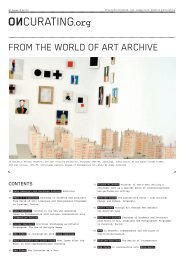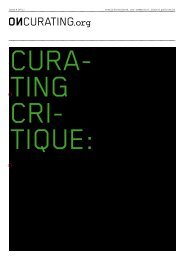Create successful ePaper yourself
Turn your PDF publications into a flip-book with our unique Google optimized e-Paper software.
017 Issue # 11/11 : PublIc Issues<br />
understanding<br />
the Public and<br />
the chinese<br />
contemPorary<br />
Li Zhenhua<br />
What is the public?<br />
The concept of the public only exists in relation to the<br />
private. We are talking about the public that is represented<br />
through squares, restaurants, train stations, and other<br />
types of public spaces. This is a concept b<strong>as</strong>ed on space,<br />
power, and the idea of sharing responsibilities. It is<br />
primarily a prediction and a keyword, inseparable from an<br />
apparent agenda.<br />
Since 1949, several typical expressions have been used to<br />
describe the interrelation between ideology and reality.<br />
These include the m<strong>as</strong>ses, the people, the liberation army<br />
soldier, the student and so on. All these words were used<br />
only to convey this ideology of the public. None h<strong>as</strong> ever<br />
represented any individual being, but they have served<br />
only <strong>as</strong> a replacement for identity – especially cl<strong>as</strong>s and<br />
political identity. Institutional changes led to the<br />
collapse of this semiotic system. This transition w<strong>as</strong> of<br />
tremendous significance, and its traces even withdrew from<br />
government propaganda. Instead, terms like people, public,<br />
friends came to represent certain groups for a certain<br />
time. While they have lost their former apparent political<br />
cl<strong>as</strong>s indication, these terms have turned into impalpable<br />
representations of a continuously changing m<strong>as</strong>s politic.<br />
Already before the introduction of communism to China, there<br />
had been a period of constant rising and falling of great<br />
revolutions. China w<strong>as</strong> in a special state of transition<br />
from feudal to civil society, mimicking revolutionary practi-<br />
ces from Europe and the former Soviet Union. Public speeches<br />
(impromptu performances) advanced the notion of democracy,<br />
generated the impulse for the people's awakening, and<br />
created the preconditions for revolution and insurrection.<br />
All of that w<strong>as</strong> different from the Chinese people's former<br />
understanding of the public, the private, feudalism, demo-<br />
cracy, dictatorship, etc. As many scholars have pointed<br />
out, under the circumstances in China back then, the con-<br />
cept of the nation state w<strong>as</strong> only gradually understood and<br />
accepted. Neither did it have any characteristics nor did<br />
it target any special group of people, but rather it became<br />
only vaguely visible when an iniquitous incident occurred.<br />
Under those circumstances, any person or party who had<br />
understood prevailing social reality could have used the<br />
absence of the public to create any kind of common ideology.<br />
The public discussed here is a constructed one. Similar<br />
people have a similar understanding of society. Through<br />
learning and observing, society, indeed even the world,<br />
can be understood and the more abundant such knowledge, the<br />
greater the potential to become open-minded. As a construct,<br />
the public can be traced back to the Chinese Communist<br />
revolution, whose propaganda and broadc<strong>as</strong>ts are perfect<br />
practical examples of the concept.<br />
1<br />
Liang Qichao w<strong>as</strong> a<br />
Chinese scholar,<br />
journalist,<br />
philosopher, and<br />
reformist during<br />
the Qing Dyn<strong>as</strong>ty<br />
(1644–1911). He<br />
inspired Chinese<br />
scholars with his<br />
writings and<br />
reform movements.<br />
2<br />
Ta Kung Pao,<br />
founded 1902 in<br />
Tianjing, w<strong>as</strong><br />
one of the most<br />
important news-<br />
papers during<br />
Republican China.<br />
It w<strong>as</strong> re-issued<br />
in Hong Kong in<br />
1948, and is the<br />
oldest active<br />
Chinese language<br />
paper today.<br />
The Long March (October 1934 – October 1936) is the best<br />
evidence for this kind of understanding. This revolutionary<br />
route w<strong>as</strong> a necessity. It w<strong>as</strong> not taken by choice,<br />
however, but created an even more expansive public space.<br />
Before, the public sphere w<strong>as</strong> often confined to the cl<strong>as</strong>s<br />
struggle between education and urbanity; moreover, it<br />
w<strong>as</strong> always under Soviet influence, but ultimately these<br />
struggles ended in failure.<br />
The revolutionary b<strong>as</strong>e, created through the Long March,<br />
and the v<strong>as</strong>t revolutionary m<strong>as</strong>ses by far exceeded the<br />
number of residents in the cities. This also established<br />
m<strong>as</strong>s mobilization <strong>as</strong> a main strategy of the revolution and<br />
consolidated the leadership position of Mao Zedong. One<br />
could argue that the Communist Party's propaganda strategies<br />
and methods still have an immediate effect. Whether<br />
they concern foreign affairs policies or the regimentation<br />
of internal information, they are all under strong control<br />
and supervision. Since that time, propaganda h<strong>as</strong> turned<br />
into an instrument of the government, seizing hold of all<br />
kinds of cultural forms, and gradually infiltrating every<br />
<strong>as</strong>pect of the Chinese people's understanding of the world<br />
and society.<br />
Between 1900 and 1949, the public sphere for urban intellectual<br />
movements w<strong>as</strong> also created. Through the writings,<br />
publications, and speeches of those intellectuals, modern<br />
culture and knowledge started to spread. For a certain<br />
period, China found itself in a special state, a need awak-<br />
ened for independence and individuality, civil rights<br />
and the freedom of speech. Liang Qichao (1873 – 1929) took<br />
the first step. 1 B<strong>as</strong>ed on his knowledge of the world, he<br />
started to compare times of change and the inevitable trans-<br />
formations in China with those occurring globally. These<br />
considerations were evoked through the elite intellectual<br />
cl<strong>as</strong>s' reflections on the change of dyn<strong>as</strong>ties, but also<br />
through his newspaper publishing work during his stay in<br />
Japan, <strong>as</strong> well <strong>as</strong> through his later employment <strong>as</strong> a<br />
teacher.<br />
The next step w<strong>as</strong> taken with the rele<strong>as</strong>e of the first edi-<br />
tion of Ta Kung Pao on 17 June 1902. 2 Further, the popularization<br />
of movies and many other cultural forms in the<br />
early 1920s showed for one thing that the level of freedom<br />
in China had reached an unprecedented state, for another<br />
that with this circulation and popularization of European<br />
and American technology, a post-industrial, globalized<br />
appearance of the world w<strong>as</strong> created.<br />
After 1949, attention should be directed towards the newly<br />
created public sphere called the square. Traditionally,<br />
people gathered at commercial and law enforcement are<strong>as</strong>,<br />
like E<strong>as</strong>t and West markets, and the execution ground. Only


![Download as PDF [10.6 MB]](https://img.yumpu.com/4266533/17/500x640/download-as-pdf-106-mb.jpg)

